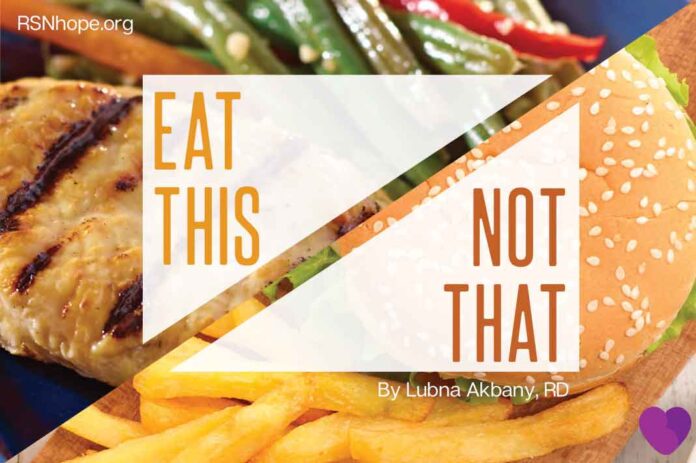As someone who has chronic kidney disease (CKD) and is also a renal dietitian, I know that choosing foods that are good for me is critical. Every day we are bombarded with yummy commercials and temptations galore. But when you have kidney disease you have to be very careful about what you put into your body and make the right choices for your kidney health.
The kidney diet is very diverse. Protein, for example, is a very important element for our bodies. However, different stages of kidney disease have specific protein intake requirements. People in early stages might need to reduce protein to help maintain kidney function. People on dialysis may need more protein.
People on dialysis also must restrict their fluid intake. Those who have a kidney transplant must watch out for foods that counteract anti-rejection medication. Some people may need to increase potassium while others must restrict potassium, and possibly take potassium binders.
5 Steps to Eating Right
Step 1: Choose and prepare foods with less salt and sodium.
Why? To help control blood pressure.
According to the American Heart Association, the ideal amount of sodium should be no more than 1,500 mg per day for most adults, especially for those with high blood pressure. Cooking from scratch and avoiding prepackaged food will help you manage your daily sodium intake as will using spices and herbs instead of salt. Read the ingredient labels carefully as salt substitutes can be high in potassium.
Step 2: Eat the right amount and the right types of protein.
Why? To reduce stress on the kidneys and preserve kidney function.
As your body absorbs protein it is converted to waste, which your kidney must filter out of your system. In people who have CKD, the kidneys are not able to remove all of the excess waste. To avoid this problem, eat small portions of protein foods. Your dietitian will work with you to help you choose the correct amount and the type of protein you need in your diet.
Animal-protein foods include chicken, fish, beef, pork, eggs, and dairy. A cooked portion of chicken, fish, beef, or pork is about 2 to 3 ounces or about the size of a deck of cards. A portion of dairy foods is ½ cup of milk or yogurt, or one slice of cheese.
Plant-protein foods include beans, nuts, and grains. A portion of cooked beans is about ½ cup, and a portion of nuts is ¼ cup. A portion of bread is a single slice, and a portion of cooked rice or cooked noodles is ½ cup.
Step 3: Choose foods that are healthy for your heart.
Why? To minimize blockages from forming in your blood vessels, heart, and kidneys.
To limit saturated and trans fats, avoid deep frying and cooking in butter. Check labels for “trans fats” or “partially hydrogenated oils” to be sure you are choosing the best oils for cooking.
Step 4: Choose foods and drinks with less phosphorus.
Why? To maintain cardiovascular and bone health.
People who have CKD can experience a buildup of phosphorus in their blood. As your kidney function decreases, your lab values may indicate that you need to reduce phosphorus in your diet. Excess phosphorus extracts calcium from bones which leads to joint pain and brittle bones, resulting in a higher risk for breaks. Processed food such as prepackaged meals, deli meat, and some fresh meat and poultry have phosphorus added to prolong shelf life. If you see words that start with “pho” on the ingredient label then there is added phosphorus in the product.
Ask your health care provider about prescribing a phosphate binder you can take with meals to lower the amount of phosphorus in your blood.
Step 5: Choose foods with the right amount of potassium.
Why? To protect the nervous system and to help your muscles function well.
Both high and low potassium levels can cause damage. Being aware of the amount of potassium in your food choices can help you manage your potassium levels.
Foods that are lower in potassium include apples, peaches, carrots, green beans, white bread and pasta, white rice, rice milk (not enriched), wheat cereals, grits, apple juice, grape juice, or cranberry juice.
Foods that are higher in potassium include oranges and orange juice, bananas, potatoes, tomatoes, brown and wild rice, bran cereals, dairy foods, whole-wheat bread and pasta, dry beans, and nuts. (Potatoes, sweet potatoes, and yams can be boiled in order to reduce their potassium content.) You may be able to include some of these foods in small amounts if you are very strict in monitoring your potassium intake. Also be aware that sports drinks, electrolyte water, and salt substitutes usually contain high amounts of potassium.
Deciding which foods to eat is very dependent on your own unique lab values. It’s important to review your labs with a renal dietitian before making any changes to your diet to be sure that you are making the best choices for your own body.
More Articles and Podcasts featuring Lubna:
Meet Renal Nutritionist Lubna Akbany, RDN, CSR
Choosing and Preparing Kidney-Friendly Holiday Foods
Treatment Options Taught from Personal Experience
Video: Weight Loss and Kidney Transplant with Lubna Abkany, RD
 Lubna Akbany, RD, CSR, is a registered dietitian nutritionist and certified specialist in renal nutrition with over 20 years’ experience. She specializes in chronic kidney disease (CKD) management and diabetes with a focus on CKD nutrition. She is a mom, a patient, and an effective nutrition communicator who loves cooking and eating delicious food with friends and family.
Lubna Akbany, RD, CSR, is a registered dietitian nutritionist and certified specialist in renal nutrition with over 20 years’ experience. She specializes in chronic kidney disease (CKD) management and diabetes with a focus on CKD nutrition. She is a mom, a patient, and an effective nutrition communicator who loves cooking and eating delicious food with friends and family.
Web ID 4041







